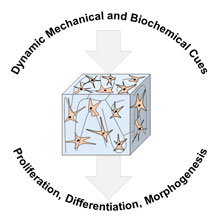Crossref Citations
This article has been cited by the following publications. This list is generated based on data provided by
Crossref.
Mitrousis, Nikolaos
Fokina, Ana
and
Shoichet, Molly S.
2018.
Biomaterials for cell transplantation.
Nature Reviews Materials,
Vol. 3,
Issue. 11,
p.
441.
LeValley, Paige J.
and
Kloxin, April M.
2019.
Chemical Approaches to Dynamically Modulate the Properties of Synthetic Matrices.
ACS Macro Letters,
Vol. 8,
Issue. 1,
p.
7.
Rahmani, Sara
Breyner, Natalia M.
Su, Hsuan-Ming
Verdu, Elena F.
and
Didar, Tohid F.
2019.
Intestinal organoids: A new paradigm for engineering intestinal epithelium in vitro.
Biomaterials,
Vol. 194,
Issue. ,
p.
195.
Camacho, Paula
Busari, Hafiz
Seims, Kelly B.
Tolbert, John W.
and
Chow, Lesley W.
2019.
3D Bioprinting in Medicine.
p.
67.
Lesha, Emal
Darouie, Sheyda
Seyfoori, Amir
Dolatshahi-Pirouz, Alireza
and
Akbari, Mohsen
2020.
Biomaterials for Organ and Tissue Regeneration.
p.
629.
Zhu, Hongyuan
Yang, Haiqian
Ma, Yufei
Lu, Tian Jian
Xu, Feng
Genin, Guy M.
and
Lin, Min
2020.
Spatiotemporally Controlled Photoresponsive Hydrogels: Design and Predictive Modeling from Processing through Application.
Advanced Functional Materials,
Vol. 30,
Issue. 32,
Bahlmann, Laura C.
Smith, Laura J.
and
Shoichet, Molly S.
2020.
Designer Biomaterials to Model Cancer Cell Invasion In Vitro: Predictive Tools or Just Pretty Pictures?.
Advanced Functional Materials,
Vol. 30,
Issue. 16,
Krüger, Melanie
Oosterhoff, Loes A.
van Wolferen, Monique E.
Schiele, Simon A.
Walther, Andreas
Geijsen, Niels
De Laporte, Laura
van der Laan, Luc J. W.
Kock, Linda M.
and
Spee, Bart
2020.
Cellulose Nanofibril Hydrogel Promotes Hepatic Differentiation of Human Liver Organoids.
Advanced Healthcare Materials,
Vol. 9,
Issue. 6,
Cotovio, João P.
Fernandes, Tiago G.
Diogo, Maria Margarida
and
Cabral, Joaquim M.S.
2020.
Engineering Strategies for Regenerative Medicine.
p.
1.
Kühn, Sebastian
Sievers, Jana
Stoppa, Aukha
Träber, Nicole
Zimmermann, Ralf
Welzel, Petra B.
and
Werner, Carsten
2020.
Cell‐Instructive Multiphasic Gel‐in‐Gel Materials.
Advanced Functional Materials,
Vol. 30,
Issue. 26,
Spiteri, Chantelle
Caprettini, Valeria
and
Chiappini, Ciro
2020.
Biomaterials-based approaches to model embryogenesis.
Biomaterials Science,
Vol. 8,
Issue. 24,
p.
6992.
Cao, Huan
Duan, Lixia
Zhang, Yan
Cao, Jun
and
Zhang, Kun
2021.
Current hydrogel advances in physicochemical and biological response-driven biomedical application diversity.
Signal Transduction and Targeted Therapy,
Vol. 6,
Issue. 1,
Borrelli, Matthew A.
Turnquist, Heth R.
and
Little, Steven R.
2021.
Biologics and their delivery systems: Trends in myocardial infarction.
Advanced Drug Delivery Reviews,
Vol. 173,
Issue. ,
p.
181.
Pérez-Pedroza, Rosario
Ávila-Ramírez, Alan
Khan, Zainab
Moretti, Manola
Hauser, Charlotte A. E.
and
De Santiago, Grissel T.
2021.
Supramolecular Biopolymers for Tissue Engineering.
Advances in Polymer Technology,
Vol. 2021,
Issue. ,
p.
1.
Rapp, Teresa L.
and
DeForest, Cole A.
2021.
Targeting drug delivery with light: A highly focused approach.
Advanced Drug Delivery Reviews,
Vol. 171,
Issue. ,
p.
94.
Zhang, Xingzhen
and
van Rijt, Sabine
2021.
2D biointerfaces to study stem cell–ligand interactions.
Acta Biomaterialia,
Vol. 131,
Issue. ,
p.
80.
Luo, Yilun
Zheng, Xiaowen
Yuan, Peiqi
Ye, Xingyao
and
Ma, Lie
2021.
Light-induced dynamic RGD pattern for sequential modulation of macrophage phenotypes.
Bioactive Materials,
Vol. 6,
Issue. 11,
p.
4065.
Wang, Zitian
Zhao, Haoran
Tang, Xiaowei
Meng, Tianyu
Khutsishvili, Davit
Xu, Bing
and
Ma, Shaohua
2022.
CNS Organoid Surpasses Cell-Laden Microgel Assembly to Promote Spinal Cord Injury Repair.
Research,
Vol. 2022,
Issue. ,
Chen, Zhenyin
and
Lv, Yonggang
2022.
Uninterrupted dynamic stiffening microenvironment enhances the paracrine function of mesenchymal stem cells for vascularization through chromatin remodeling.
Materials & Design,
Vol. 224,
Issue. ,
p.
111328.
Landon‐Brace, Natalie
Li, Nancy T.
and
McGuigan, Alison P.
2023.
Exploring New Dimensions of Tumor Heterogeneity: The Application of Single Cell Analysis to Organoid‐Based 3D In Vitro Models.
Advanced Healthcare Materials,
Vol. 12,
Issue. 26,


